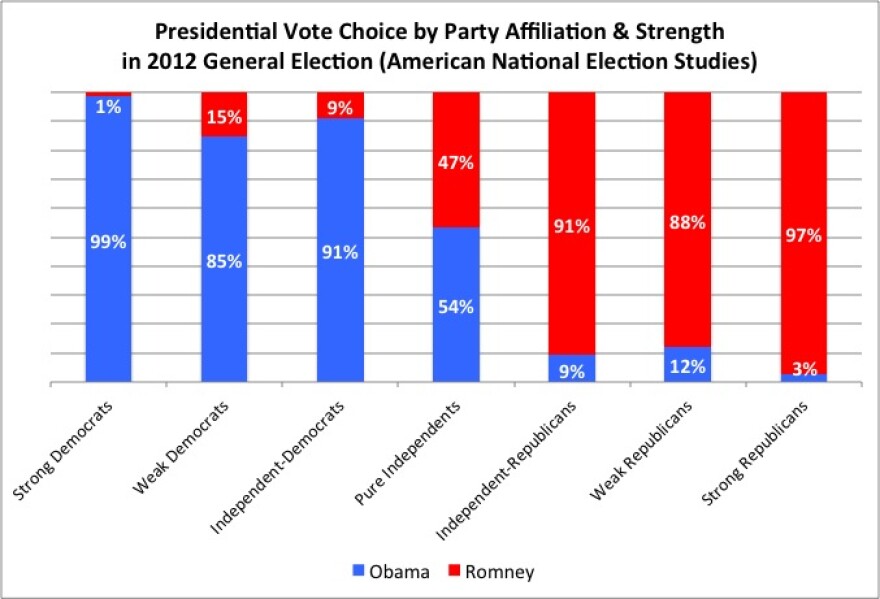As we head into the final weeks of the general election campaign, attention is turning to who will make up the electorate, with a focus on North Carolina’s fastest-growing voter group: unaffiliated.
With registered unaffiliated voters outnumbering one of the two major parties in more than half of the state’s 100 counties, and four counties having unaffiliated voters as the majority of registered voters, many believe that the grand prize this fall could be this 27 percent of the electorate that are up for grabs.
But who might these unaffiliated voters be?
In looking more closely at some basic data from the North Carolina State Board of Elections website, some basic patterns can be seen with unaffiliated voters.
First, unaffiliated voters tend be younger. Among registered Democrats and Republicans, voters under the age of 40 are 34 percent and 32 percent, respectively; among registered unaffiliated voters, nearly half — 49 percent — are under the age of 40.
In fact, this demarcation of those under or over 40 years old seems to be a critical line in many different aspects.
For both voters between 18-25 and 26-40, unaffiliated voters make up 37 and 33 percent of both age categories, respectively. Among 18-25 year olds, registered Republicans are barely one-quarter of the voters; within those 26-40 years old, GOP registration is 27 percent.
In addition to age, location plays another important factor in these unaffiliated voters.
Statewide, 58 percent of registered Democrats and 57 percent of registered Republicans are found within urban and suburban counties, while two-thirds of all unaffiliated voters are in urban and suburban counties.
The new divide within the state’s politics is becoming more and more the urban-rural split. Within urban counties, Democrats lead with 45 percent of registered voters. Unaffiliated voters, at 28 percent, surpass Republicans at 27 percent.
Among urban 18-25 and 26-40 year olds, Democrats are (not surprisingly) 42 and 43 percent of the voters, with unaffiliated voters coming in at 37 and 34 percent.
In rural counties, while Democrats are 43 percent of the registered voters, Republicans make up 32 percent to unaffiliated’s 24 percent.
Among voters 18-25 in rural counties, unaffiliated voters are 36 percent, while Democrats are 35 percent and Republicans are 27 precnet. For voters 26-40, Democrats are 37 percent, unaffiliated voters 32 percent, and Republicans are 30 percent.
In suburban counties, which some consider the swing parts of the state, registered Democrats and Republicans are 36 percent each, with unaffiliated voters at 28 percent.
If you look inside those suburban areas, unaffiliated voters make up a plurality of both 18-25 and 26-40 year olds (39 percent and 35 percent, respectively).
But even with this rise of unaffiliated voters, two important points need to be made.
First, if we assume that unaffiliated equates to ‘independent voters,’ then how independent are these voters in terms of their voting behavior?
Recent exit polls have shown that self-identified partisans typically vote 90 percent or more for their party’s presidential candidate, while independent voters tend to split their votes between the two parties.
But a different story may emerge if you were to ask these independent voters, “Do you lean to one party over the other?”
From the 2012 American National Election Study, voters were asked if they were strong or weak partisans. If they were independent, did they lean to one party or the other? Strong and weak Democrats were 35 percent of the electorate, while strong and weak Republicans were 27 percent. Independents were a plurality, but GOP-lean and Democratic-leaning indies were 12 percent each, leaving pure independents at about 14 percent of the electorate.
And when you ask these independents how they voted in 2012’s presidential election, you get a surprising response.

Independents who lean to one party or the other were just as strong in voting for that party’s candidate as the self-identified strong partisans. Only pure independents were the classic split down-the-middle voter.
The second observation about unaffiliated voters in North Carolina is whether they decide to vote at all.
In looking at the past five elections, in presidential years, registered Democrats and Republicans tend to have turnout rates at 70 percent or greater; registered unaffiliated voters are 60 percent or barely above.
In the 2006 and 2010 mid-term election years, registered partisans have 40 to 50 percent turnout, while registered unaffiliated voters had turnout rates of 28 percent in 2006 and 33 percent in 2010.
And if you look at unaffiliated voters’ numbers within the pool of eligible voters and their percentage of the electorate, you see that those voters just don’t show up at their registration numbers.

So while the percentage of registered unaffiliated voters has grown from 19 percent in 2006 to 27 percent this year, the big question for both parties is whether they will show up for mid-term elections.
If the past two mid-term elections are any indication, probably not.


